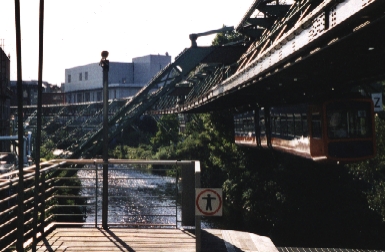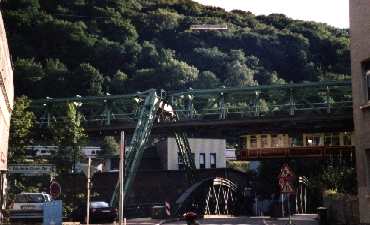| Gothic Steam Phantastic > Information > Hoovering |
 Hoovering ferries and the Schwebebahn |
 |
| -*- Home -*- Daleth-*- I&I RPG -*- Information -*- Forum -*- Credits -*- Links -*- |
|
In Europe, and probably elsewhere in the world, the nineteenth century had some inventions that strike us now as being somewhat steampunk: stranger than fiction. They have something in them, that makes them a kind of weird to the modern eye, they should have been used in steampunk novels but nobody thinks about it because it is so strange. Two of them I present here: the Schwebebahn and the Hoovering Ferries.
Transport became very important at the end of the nineteenth century. Not only cargo, but also people had to move quickly from one place to the other. Time became money, and people did no longer work at home. Trains, automobiles, streetcars and bicycles did a great job in moving the masses around. Where transport crossed, there was a small conflict. This was mostly visible where water had to be crossed. Water was a main transport line, boats were very important to the economy. A bridge would in many cases obstruct the traffic on the water (remember a lot of ships sailed and the sails have to go down, with the masts, to pass a bridge). Ferries were very handy and used a lot. As an example, in the middle of Amsterdam there used to be a ferry that crossed one of the famous canals that was not even 10 metres wide; one could walk to the next bridge in less than 10 minutes: the ferry saved only a quarter of an hour and costed a few cents. But it was in use. But ferries somehow didn’t work well; their wires still obstructed the traffic on the water and the ship itself took it’s space on the water. So the nineteenth century engineers invented the hoovering ferry. In fact, it is a very large bridge, that supports a platform that is moved to and fro just above the water. On the platform, both passengers and cars stood, but even trams could be taken over the water this way. It was especially useful at harbours, were large ships had to sail in. Because harbours were strategic in war, many of the hoovering ferries have been destructed during the second world war. The pictures show the hoovering ferry in Marseille, France.
In Europe, the platform was used with electricity, but it is easy to convert this into a steam powered construct. It’s an easy device, that pulls the platform from one side of the high bridge to the other. The Schwebebahn Another problem in transport and traffic was the cause of the invention of the Schwebebahn. The community of Wuppertal, Germany, was an industrial community were people had to move along the 22 kilometres long valley of the Wupper river. Being a rather old industrial region, the valley was already full of houses and factories. Transport on the water was not possible: the Wupper is a small, shallow river. The engineers now invented the Schwebebahn - the hoovering rail- that was build above the river - for almost the full 22 kilometres. There is a bridge-like construct over the full length of the river, and a train running under the rails that are supported by this bridge. The stations are build high, you have to climb the stairs before you come to the platform and can enter the carriages of the train. The trains cross the city so high, there is never any obstruction by them. The Schwebebahn still functions as a normal part of public transport in Wuppertal. There are possibilities for rides in nostalgic cars.
Hoovering instead of flying Both constructs seem to be a solution that is close to flying. Where in many steampunk stories the air is full of science-fiction aircraft, a more realistic steampunk city can be full of constructs like the hoovering ferries or the Schwebebahn. Both constructs let the other traffic pass underneath without any disturbance, and both constructs allow the passengers to have a view of the city from above. Of course, the Schwebebahn can be compared to the trains that crossed the cities on their high bridges, but the appearance of the Schwebebahn is much lighter with it’s steel construct than the normal railroad bridges. The hoovering ferry, on the contrary, is even more modern, because the engine that moves the platform is not on the platform itself, thus the ferry moves in silence over the city. The subway can solve many problems in transport as well. However, in a genre that owes a lot to visible gadgets, a subway it too hidden to be of any atmospheric use. I think that with a bit of tinkering and expanding the idea of both constructs, a more believable steampunk world can be build that those cities with the many aircraft flying around it’s skyscrapers. © Yaghish 2004 |
| Links |
| -*-© Steammasters 2003-*- |
| ^ Up |



